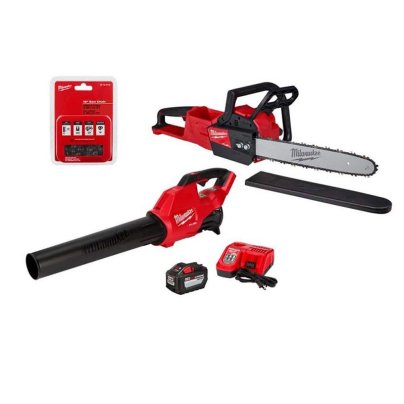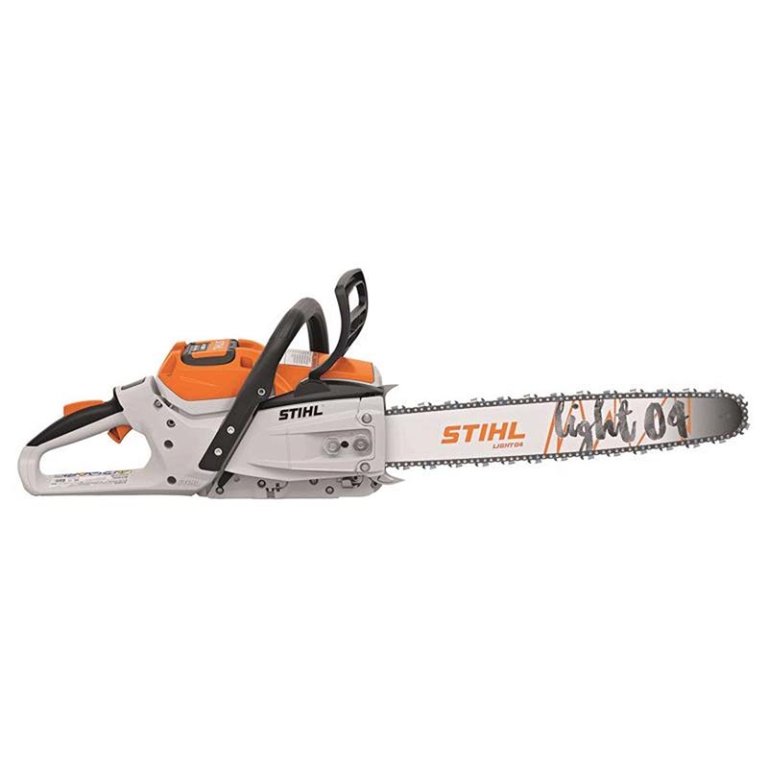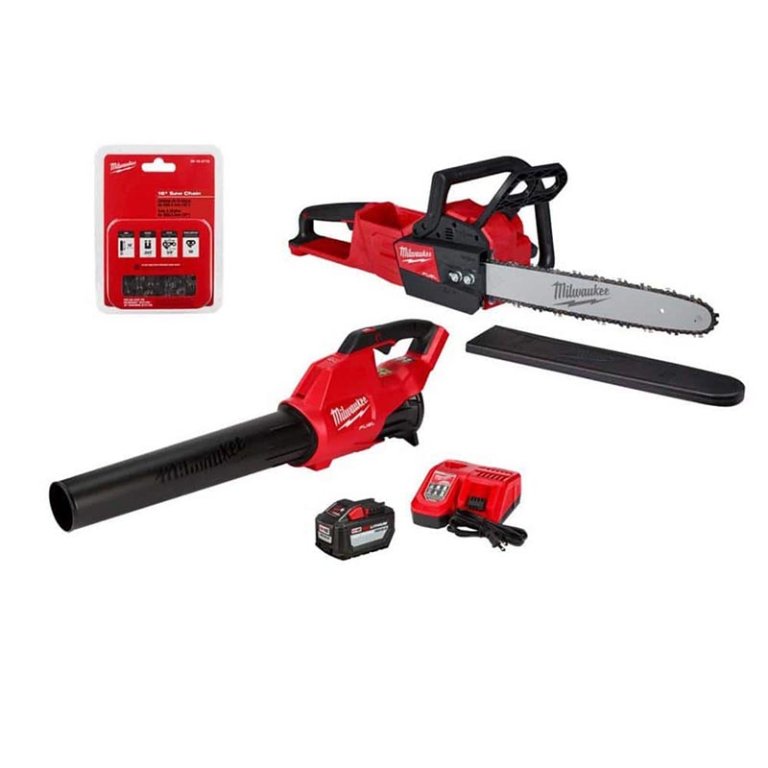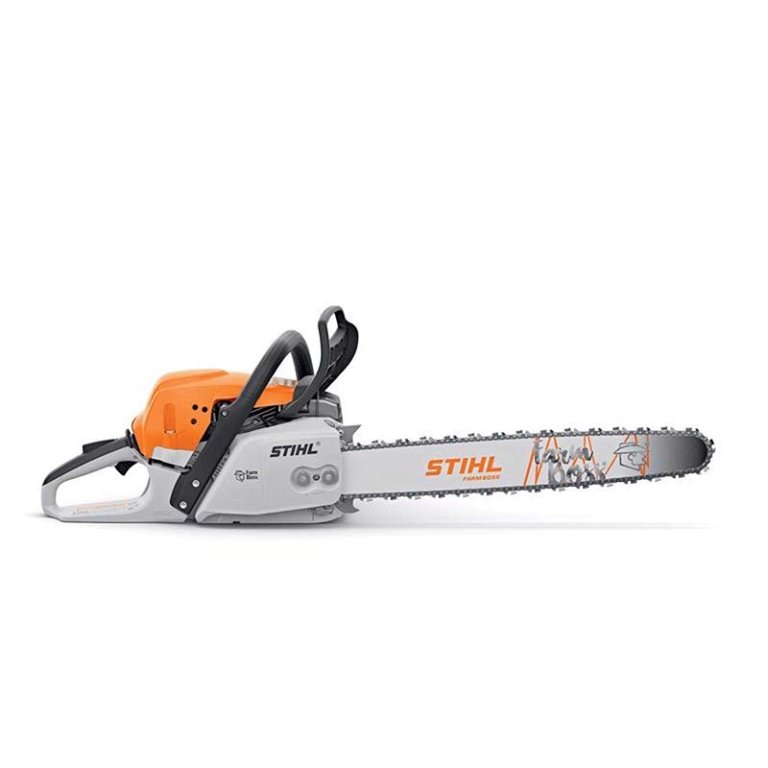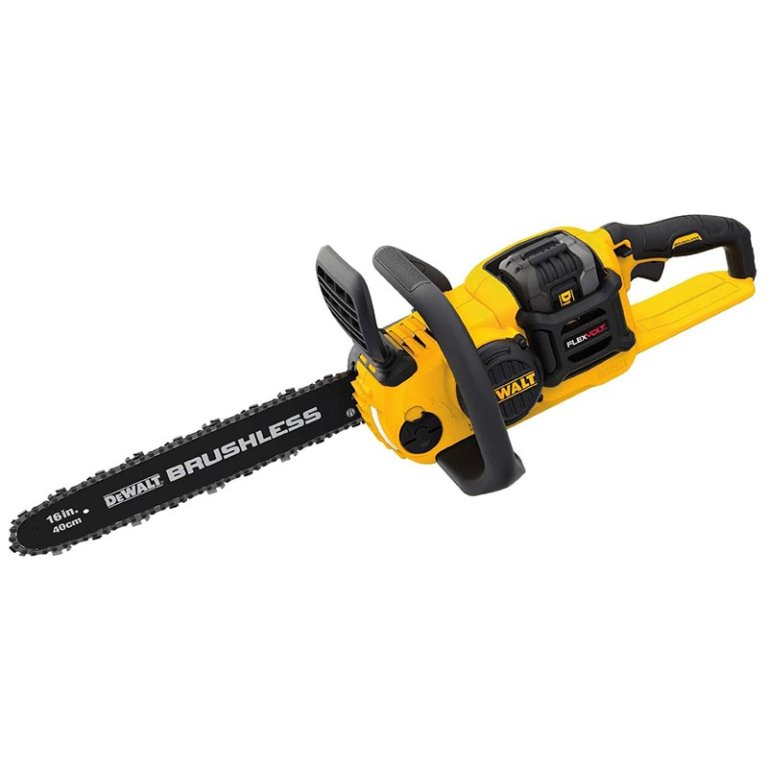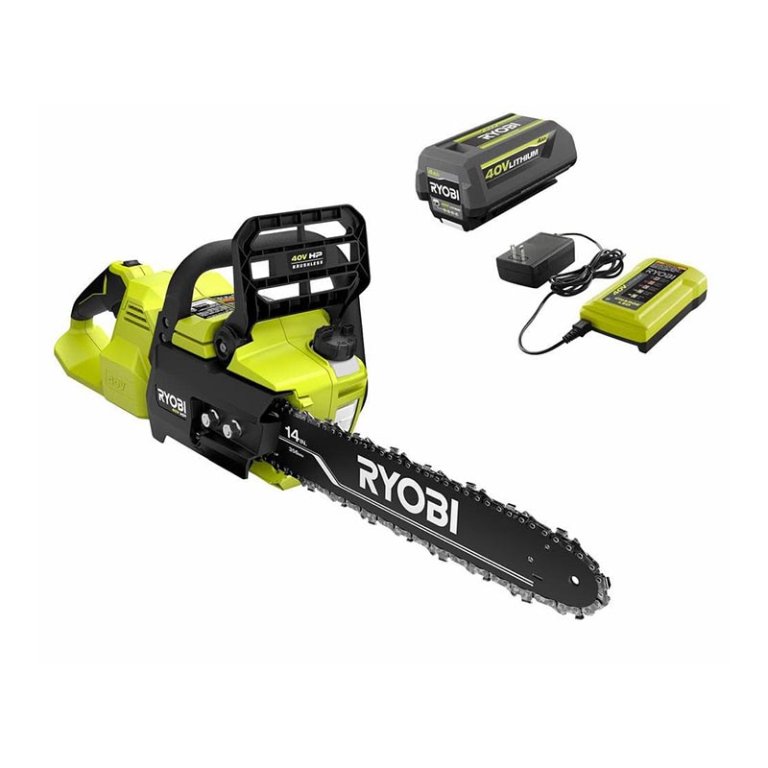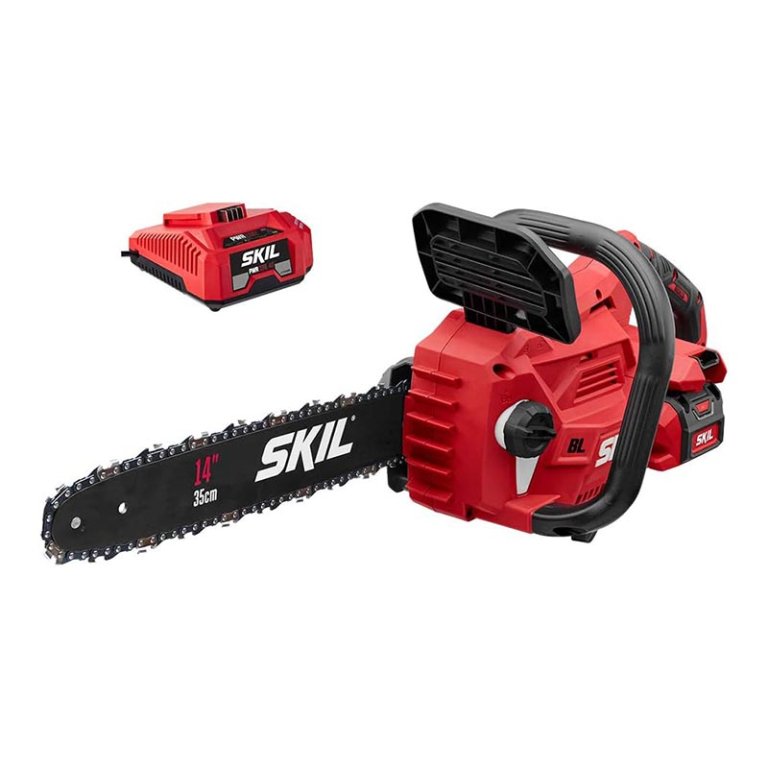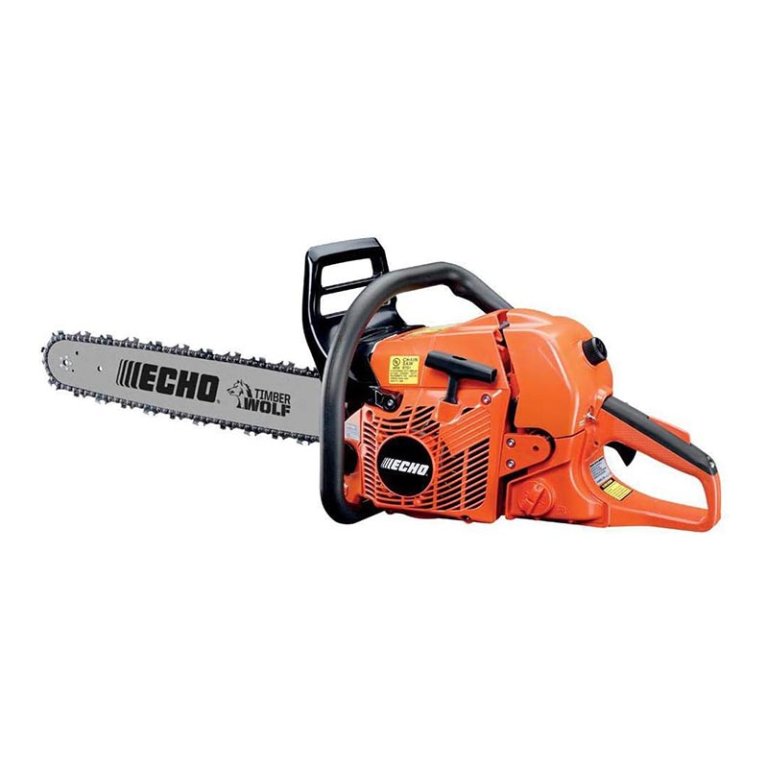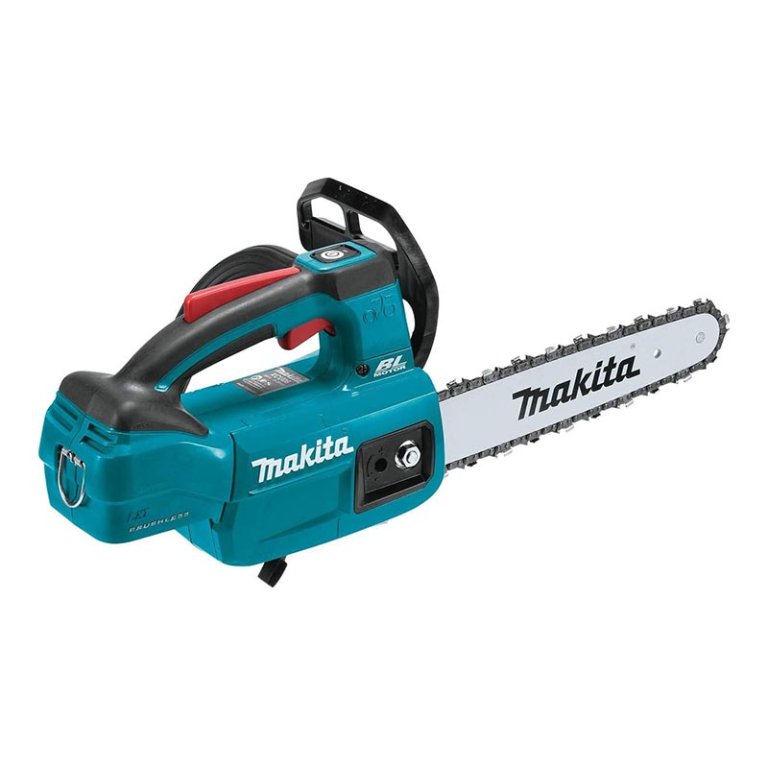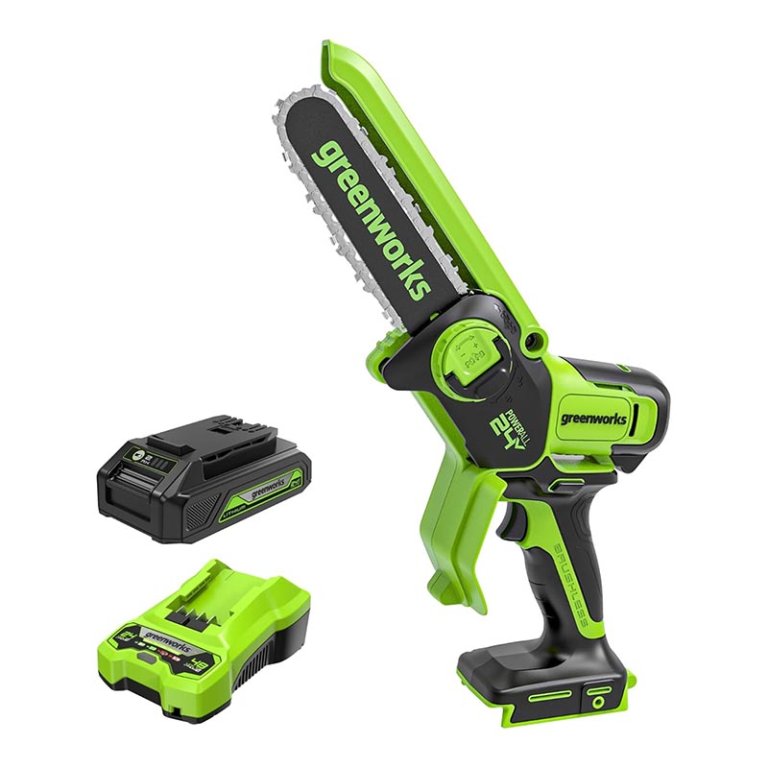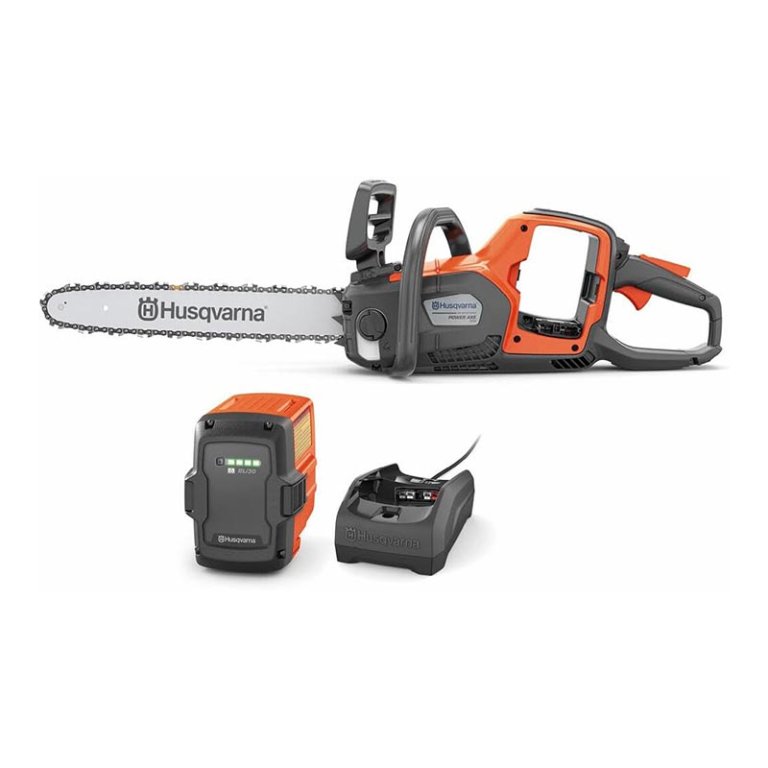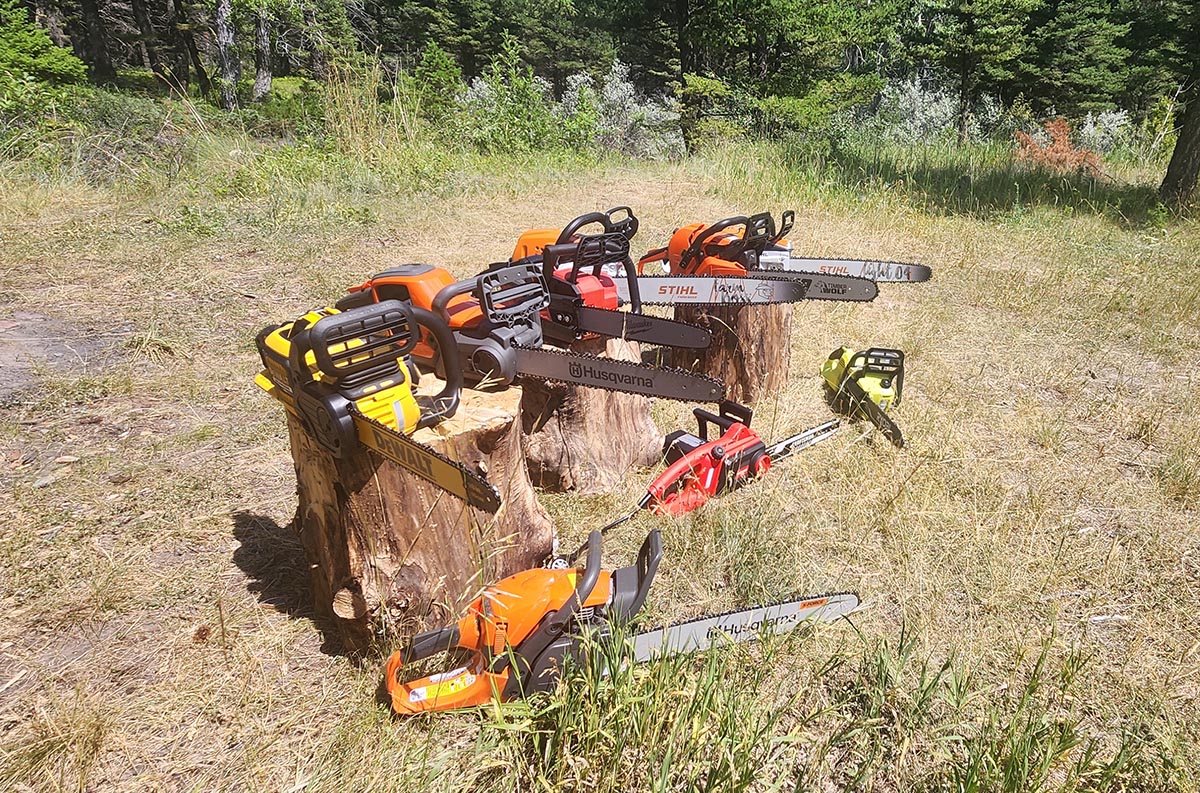
We may earn revenue from the products available on this page and participate in affiliate programs. Learn More ›
Yard maintenance, tree trimming, and putting up firewood will keep you busy throughout the year. It’s hard work, and you’ll need a chainsaw that’s up to the task. Finding the best chainsaw that offers plenty of power and cutting capabilities with the right size bar and value isn’t easy. That’s why we put 12 models to the test in different conditions and environments. The Stihl MSA 300 C-O 16″ Battery Chainsaw came out on top of our list thanks to its light weight, impressively quiet operation, and supreme IPX4-rated battery power.
We cut everything from brush to deadfall and large trees to find the best performers for different jobs. The range of saw sizes and uses is diverse, and we found great options for light-duty backyard tasks, medium-duty cutting, and for the heavy-duty tree felling and firewood jobs. We had more than one favorite and were impressed by both gas- and battery-powered models. In fact, the market is competitive, and several saws went head-to-head with very close results.
The following are the saws tested and awards given based on a summer of cutting and trimming.
- BEST OVERALL: Stihl MSA 300 C-O 16″ Battery Chainsaw
↓ Jump to Review - BEST BANG FOR THE BUCK: Milwaukee M18 Fuel 16″ Chainsaw Kit With Blower
↓ Jump to Review - UPGRADE PICK: Husqvarna 450 Rancher 20″ Gas Chainsaw
↓ Jump to Review - BEST FOR FIREWOOD: Stihl MS 271 Farm Boss 20″ Gas Chainsaw
↓ Jump to Review - BEST CORDED: Craftsman 16″ 12-Amp Corded Chainsaw
↓ Jump to Review - MOST VERSATILE: DeWalt FlexVolt 60V MAX 16″ Battery Chainsaw Kit
↓ Jump to Review - BEST LIGHT-DUTY: Ryobi One+ 40V HP 14″ Chainsaw Kit
↓ Jump to Review - BEST MEDIUM-DUTY: Skil PwrCore 40 Brushless 40V 14″ Chainsaw Kit
↓ Jump to Review - BEST HEAVY-DUTY: Echo CS+590 Timber Wolf 18″ Gas Chainsaw
↓ Jump to Review - BEST FOR CAMPING: Makita 18V LXT Brushless 10″ Top Handle Chainsaw
↓ Jump to Review - BEST FOR GARDENS: Greenworks 24V 6″ Brushless Battery Pruner Saw
↓ Jump to Review - BEST ELECTRIC: Husqvarna Power Axe 350i Electric Chainsaw
↓ Jump to Review
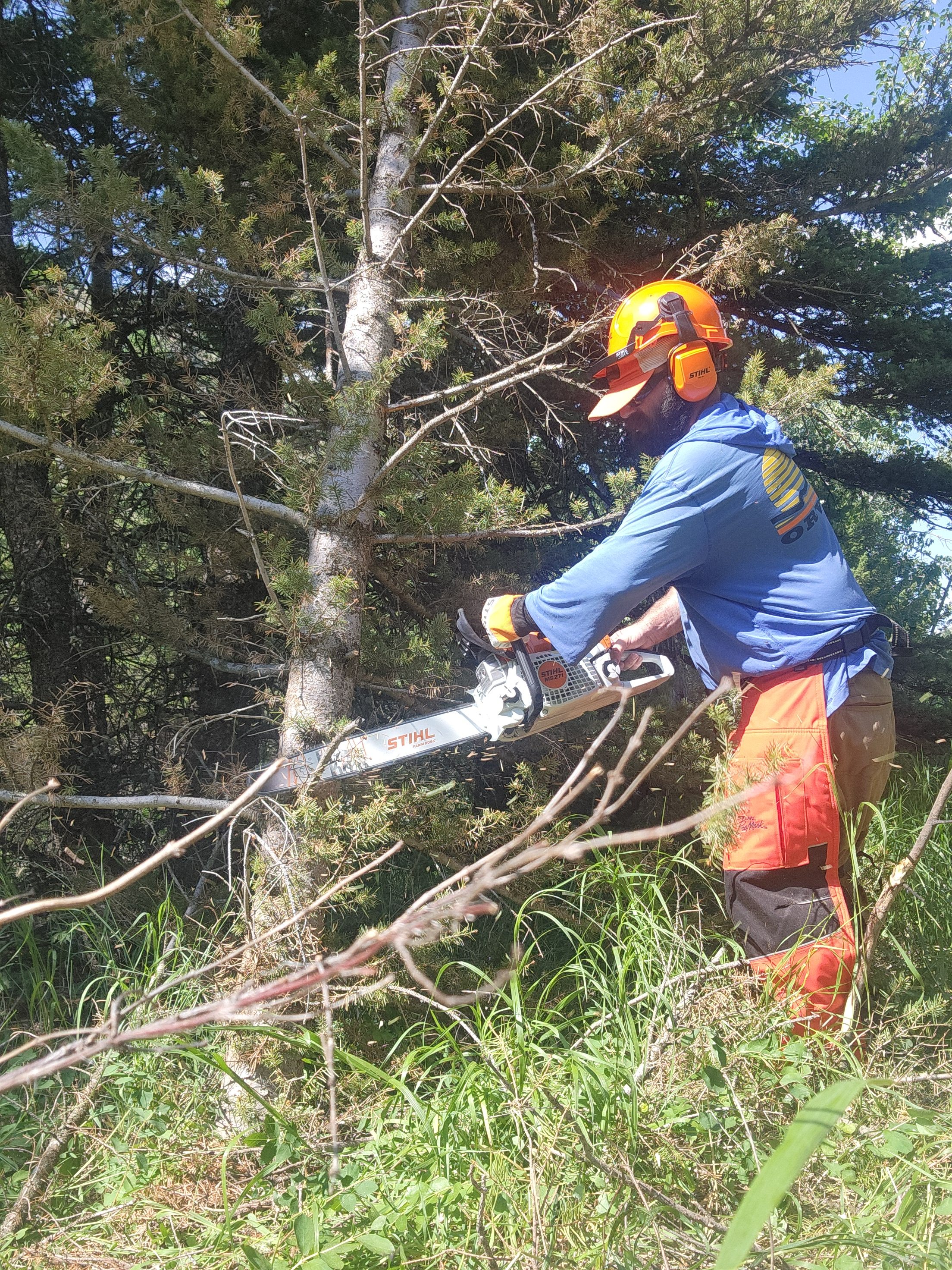
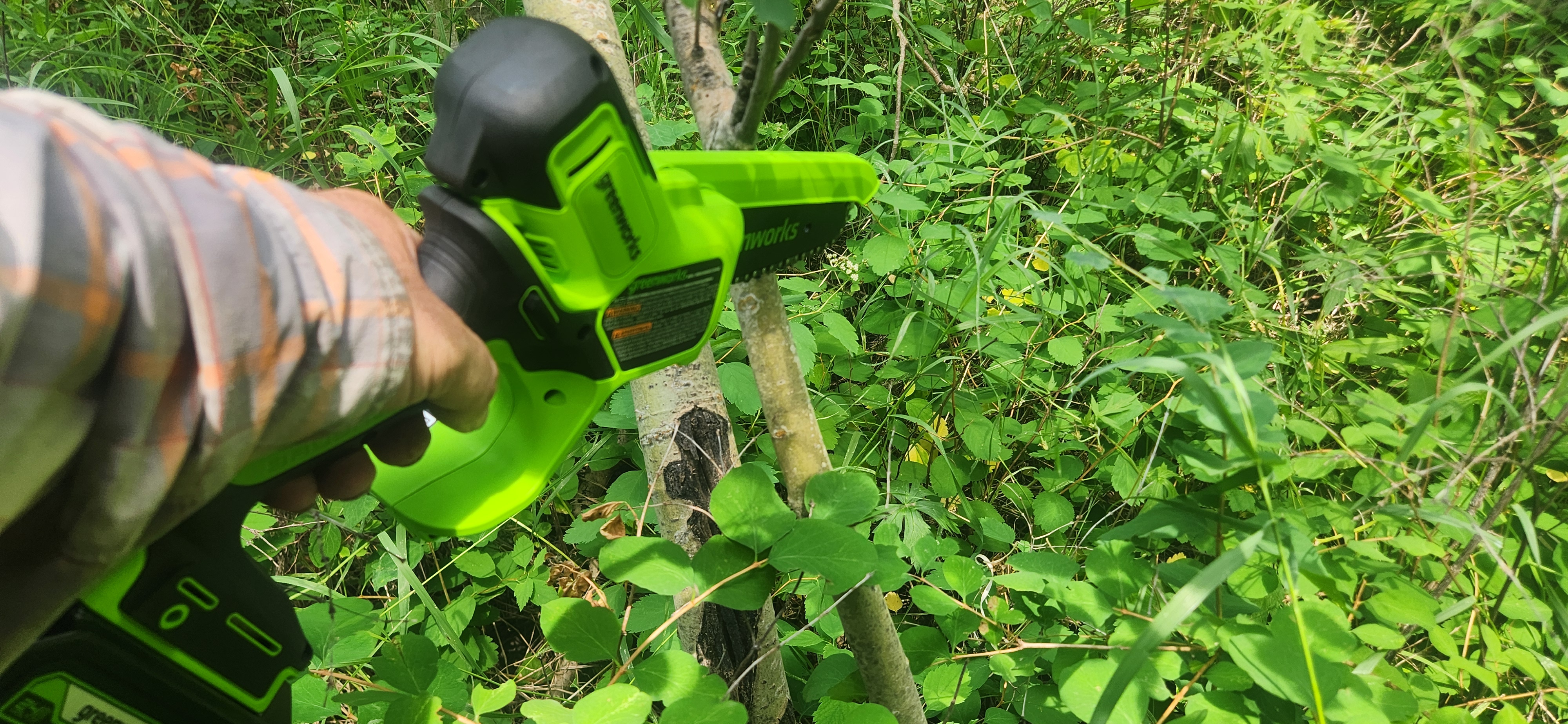
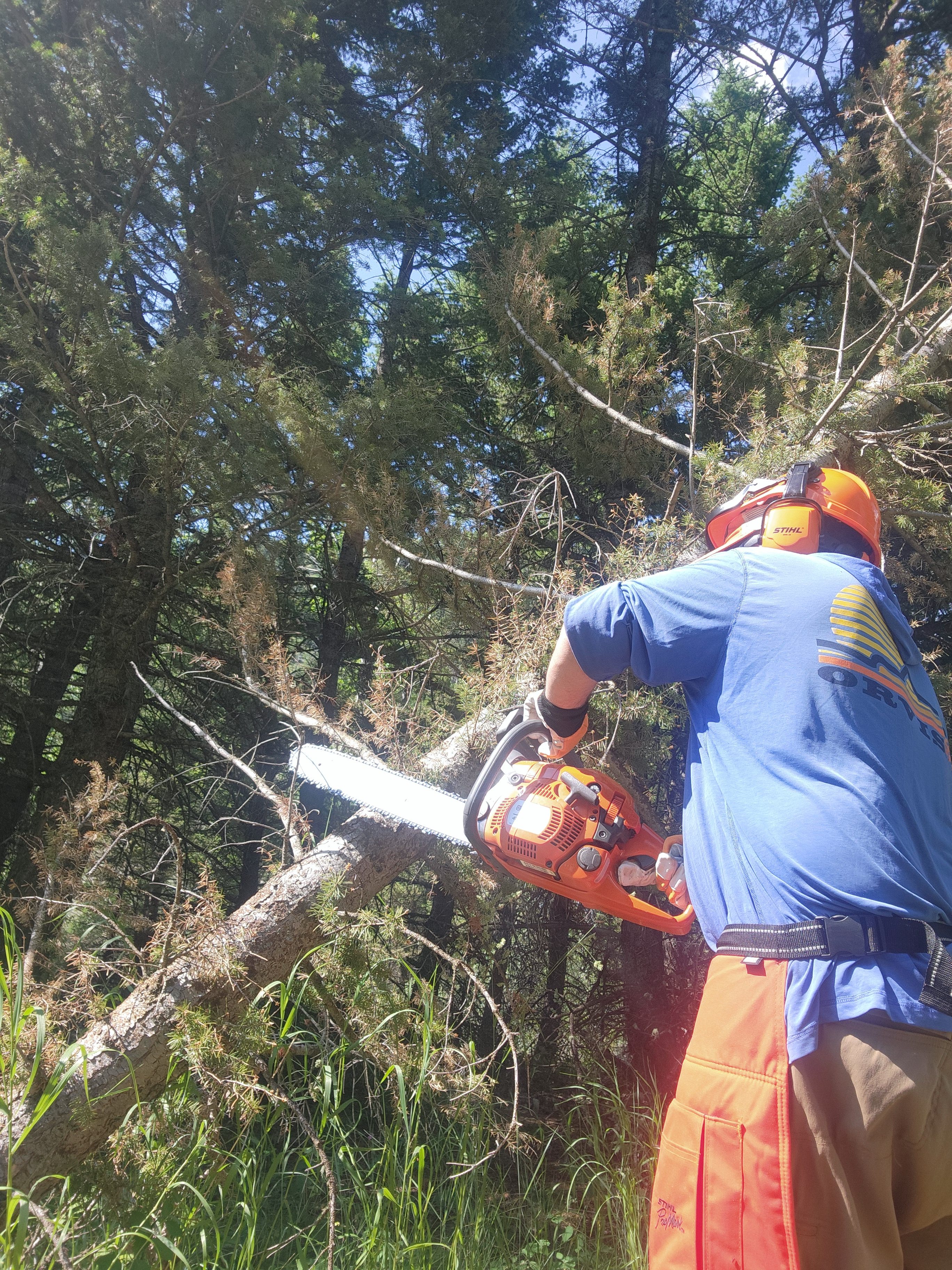
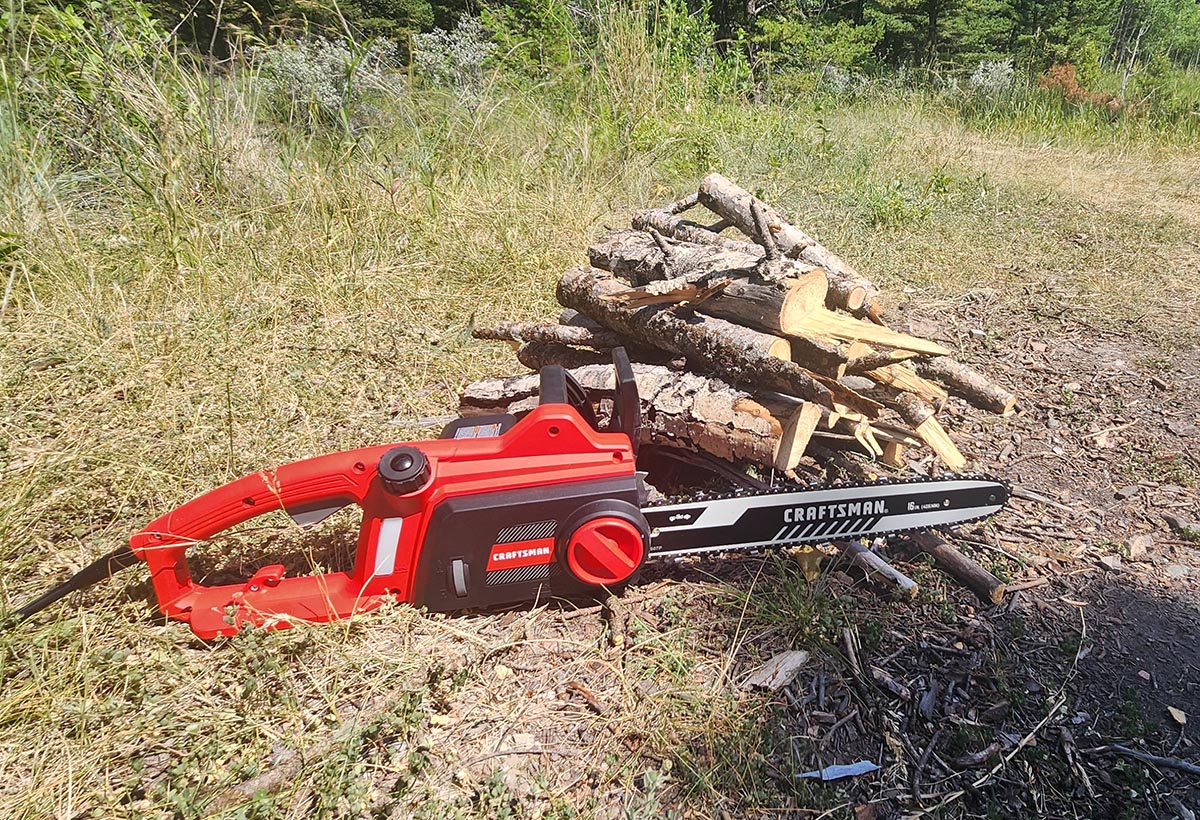
| Testing Stats | |
| Products tested | 12 |
| Time spent testing | 2 weeks |
| Tests performed | 5 |
| Price range | $135 to $1,290 |
Our Top Picks
Based on our testing, we’ve found that these are some of the best tools that can help you manage trees, collect firewood, and more.
Best Overall
Stihl MSA 300 C-O 16" Battery Chainsaw
What We Like
- Single battery runs for several hours
- Excellent torque and cutting power for heavy-duty jobs
- Lightweight design is easy to lift and maneuver
- Cuts straight and at angles with ease
What We Don’t Like
- Battery dependent is best for day-use tasks
Product Specs
- Power source: 36-volt (V) battery
- Bar size: 16, 18, or 20 inches
- Weight: 14.1 pounds with battery
Our Ratings: Ease of Use 5/5; Performance 5/5; Maneuverability 5/5; Noise 5/5; Value 5/5
Performance and ease of use puts this amazing saw at the top of the list. I was thoroughly surprised by the battery-powered performance when pitted against gas-powered models. It’s quieter and lighter but offers the same power and performance. The lightweight design was a real differentiator among all of the battery-powered models. It was easier to use when lifting and making cuts in tricky positions, and I found battery-powered models in general to be more enjoyable to use on longer days in the woods. This chainsaw flat out excelled at dropping trees, delimbing, and slicing through deadfall to fill trailers with firewood.
The only downside to any battery-powered chainsaw is the ability to work for several days at a time in remote settings. With two batteries, however, I had no issue running this saw near continuously for full days in the field. The IPX4-rated battery performed extremely well and had no issues with dew or the light rain that hit one day.
Overall, it’s hard to beat this electric chainsaw. I used an 18-inch bar, and it quickly rose to my preferred option for stacking firewood and working in the woods.
Get the Stihl MSA 300 C-O chainsaw at Ace Hardware or Stihl.
Best Bang for the Buck
Milwaukee M18 Fuel 16" Chainsaw Kit With Blower
What We Like
- Very smooth and controlled cutting
- Exceptional battery quality and longevity
- Easy to handle and operate
- Packaged with a blower
What We Don’t Like
- Not ideal for commercial or larger jobs
Product Specs
- Power source: 18V battery
- Bar size: 16 inches
- Weight: 13.9 pounds
Our Ratings: Ease of Use 4.8/5; Performance 4.5/5; Maneuverability 5/5; Noise 4/5; Value 5/5
You get two tools packaged in this kit. While the chainsaw is the main point of interest for us, the blower is a great addition for residential use. You can and trim then follow up to clean surfaces and dust. Both the chainsaw and blower work exceptionally well. The chainsaw held its own with the best of them and is a great overall value.
I was impressed by the high quality and powerful batteries. At 12 amp hours (Ah), the battery lasts for a very long time and delivers consistent power. I think it’s one of the best battery options available in terms of power and performance. The saw itself offered excellent cutting capabilities. I started with some light delimbing and eventually moved to cutting through deadfall for firewood. It didn’t vibrate or stick and had no problems slicing through thicker logs. It was also lightweight and very easy to start, stop, and maneuver throughout the day.
For those who are new to chainsaw setup, this one comes preassembled and only needs the chain adjusted to finalize assembly. Add oil, charge the battery, and you are ready to work. It’s a great deal for a very smooth and powerful chainsaw.
Get the Milwaukee chainsaw at The Home Depot or Ace Hardware (chainsaw only).
Upgrade Pick
Husqvarna 450 Rancher 20" Gas Chainsaw
What We Like
- Consistent and smooth cutting saw
- Excellent power and torque for larger logs
- Easy-starting and smooth-running gas engine
- Does exceptionally well cutting at angles
What We Don’t Like
- Overpowered for small backyard tasks
Product Specs
- Power source: Gas engine
- Bar size: 18 or 20 inches
- Weight: 11.33 pounds
Our Ratings: Ease of Use 4.3/5; Performance 5/5; Maneuverability 4/5; Noise 3/5; Value 5/5
Husqvarna is an industry leader in the power tool and small engine market, so it’s no surprise that they have a great selection of chainsaws. I actually used to run this model on a regular basis, so I was already familiar with its performance. The saw has a ton of torque and is one of my favorite all-time models for dropping trees and working through bigger rounds.
The 50.2-cubic-centimeter (cc) engine is easy to start and warm up. It seems less finicky and requires less tuning than other saws at variable elevations as well. This makes it especially nice for those who work on the move and have some geographical range. The 20-inch bar is excellent for working in the woods and doing just about everything short of commercial work.
I also find that this saw feels pretty mellow in the hand. It has little vibration and is easy to control. If you have a property that requires regular tree work or you spend time working in the woods, this is a great chainsaw to use. It’s reliable and hardworking. I managed to put up a cord of wood in pretty fast order with the Rancher and did plenty of camp cutting as well.
Get the Husqvarna 450 Rancher chainsaw at Amazon, Lowe’s, or Tractor Supply Co.
Best for Firewood
Stihl MS 271 Farm Boss 20" Gas Chainsaw
What We Like
- High-powered saw capable of most jobs
- Runs great when properly tuned
- Can last a lifetime with proper maintenance
- Excellent customer support and resources
What We Don’t Like
- Runs best when tuned properly; might require expert assistance
Product Specs
- Power source: Gas engine
- Bar size: 18 or 20 inches
- Weight: 12.3 pounds
Our Ratings: Ease of Use 4.5/5; Performance 5/5; Maneuverability 5/5; Noise 3/5; Value 5/5
While the Stihl electric model took our top spot, this remains as my top chainsaw for firewood when camping and running several days in a row. There are times when charging batteries simply isn’t feasible, and it’s nice to have a reliable gas engine that can run all day.
Stihl engineering is among the best in the world, and that means you’ll want to tune this chainsaw properly—or have it tuned by a Stihl rep for the most efficient performance. Luckily, mine was dialed in and started immediately, requiring no extra steps to fine-tune everything.
I had used this saw in the past as well and was familiar with how it ran. As with previous experiences, it delivered smooth performance across long cutting periods. While I didn’t have a means of monitoring fuel economy, this saw seems to eat a little less than other models. When it comes to chainsaws, many people are either loyal to Stihl or Husqvarna. The Husqvarna feels like it has a bit more torque while the Stihl is supersmooth and holds the line while cutting.
Everyone has to choose for themselves, and I think you can’t go wrong with this Stihl for firewood, property work, and even some commercial applications.
Get the Stihl Farm Boss chainsaw at Ace Hardware.
Best Corded
Craftsman 16" 12-Amp Corded Chainsaw
What We Like
- Can run endlessly with a power outlet available
- Extremely lightweight and easy to use
- Has plenty of torque and power for small- to medium-size jobs
What We Don’t Like
- Limited range due to power cord requirement
Product Specs
- Power source: Electric cord
- Bar size: 16 inches
- Weight: 6.2 pounds
Our Ratings: Ease of Use 3.8/5; Performance 3.5/5; Maneuverability 3/5; Noise 4/5; Value 3.5/5
While a cord-connected chainsaw isn’t for everyone, it’s worth considering if you work within reasonable range of a power outlet. I actually took this saw into the woods and plugged it into the inverter on my camper battery. I was able to set up a load of firewood around camp in short order, but it’s best used at home where it won’t drain battery systems.
The lack of a battery does make this a very affordable option, and it’s a very capable saw for small- and medium-duty tasks. I wouldn’t drop a big pine tree with this model, but I did run it through a few moderately sized logs, and it cut really well. If you have wood on the ground or need to trim around your property, this chainsaw is a great option.
While having a cord comes with some limitations, I did enjoy the performance and think the Craftsman 16-inch 12-amp can serve property owners well when they need a capable chainsaw on occasion but don’t want to bother with engines or batteries for jobs beyond the reach of power outlets.
Get the Craftsman chainsaw at Amazon, Lowe’s, or Ace Hardware.
Most Versatile
DeWalt FlexVolt 60V MAX 16" Battery Chainsaw Kit
What We Like
- Lightweight and easy to use
- Cuts well on small, mid-size, and even some larger logs
- Great support saw on bigger projects
- Ideal for many property owners and managers
What We Don’t Like
- Saw loses power before batteries die completely
Product Specs
- Power source: Battery
- Bar size: 16 inches
- Weight: 12.2 pounds
Our Ratings: Ease of Use 4/5; Performance 3.5/5; Maneuverability 3/5; Noise 4/5; Value 4/5
I started using this saw for delimbing, and it worked really well. It’s light and makes quick work of cleaning up a tree. The power and torque are great and, eventually, it moved to mid-size trees, making smooth cuts into rounds of firewood. I did prefer the bigger bar sizes for bigger logs, but this one had no problem with the average cuts.
DeWalt makes top-tier batteries and a large suite of tools, making this chainsaw a great fit for anyone who already owns tools under the brand. The FlexVolt means batteries can transition between other tools. I even tried one of the beefy 6-amp-hour 60V batteries on a Dewalt drill, and it added power over my smaller batteries.
Overall, this saw is great for someone wanting a model that can handle a broad range of tasks. I did prefer the Milwaukee, but the two are close in performance and weight. If you’re invested in DeWalt batteries and tools, definitely consider adding this to your collection.
Get the DeWalt chainsaw at Ace Hardware, Tractor Supply Co., or The Home Depot.
Best Light-Duty
Ryobi One+ 40V HP 14" Chainsaw Kit
What We Like
- Lightweight and easy to handle
- Comes preassembled to get started quickly
- Great for working in the yard
- Clear bar oil reservoir for easy level monitoring
What We Don’t Like
- Light-duty saw isn’t ideal for bigger projects
Product Specs
- Power source: Battery
- Bar size: 14 inches
- Weight: 6.6 pounds
Our Ratings: Ease of Use 4.3/5; Performance 3.5/5; Maneuverability 3/5; Noise 4/5; Value 3.5/5
Homeowners looking for a light to mid-duty chainsaw at a great price point will want to take a look at this 14-inch Ryobi model. It comes with a 4-amp-hour battery that lasts for hours, and it functions on the same Ryobi battery platform as their suite of electric tools. I love several of their other tools, so this one is a natural fit for my personal use.
I did some pretty intensive delimbing with this saw, and it cuts smooth on the small stuff. I found it really easy to handle and cut at angles or in difficult positions. I think it would be perfect for clearing thickets and managing growth on personal properties. It worked well as a firewood support saw and for small camp wood, but I wouldn’t use it for the larger stuff.
If you are new to battery-powered chainsaws and want something for home and camp chores, this is a great entry into the market. It has a nice price point as one of the few sub-$200 chainsaws, and it can handle a wide range of cutting tasks. I’ll be using this one moving forward for small jobs at home. Plus, I’ll use it on camping trips as it can stack enough firewood for the weekend in less than an hour.
Get the Ryobi chainsaw at The Home Depot, Walmart, or Amazon.
Best Medium-Duty
Skil PwrCore 40 Brushless 40V 14" Chainsaw Kit
What We Like
- Great for yard work and small to mid cuts
- Great torque; smooth-running model
- Nice grip for easy handling
What We Don’t Like
- Plastic shell isn’t made for heavy abuse
- Battery life is limited
Product Specs
- Power source: Battery
- Bar size: 14 inches
- Weight: 11.5 pounds
Our Ratings: Ease of Use 4/5; Performance 3.8/5; Maneuverability 4/5; Noise 4/5; Value 4/5
The Skil 14-inch chainsaw proved itself valuable for small and mid-size cuts. We have plenty of options that bridge the gap between medium- and heavy-duty tasks, but this one is more geared towards the limb work and yard work.
I enjoyed the lightweight design, plus it’s very easy to hold, operate and maneuver. It has solid power and torque, and the 2.5 Ah battery can run hard for an hour or so. This saw isn’t built for the demands of daily use in the woods, but it’s great for the average property owner. Cleaning, pruning, and hacking down thickets will be a breeze with this saw.
I put it through its paces for a few weeks and found the performance to be consistent. Durability feels good as well although it likely won’t handle the same abuse as the heavier models on this list. It has a plastic shell that could become damaged without proper care. Otherwise, the bar and chain have a nice fit, the grip is comfortable, and it’s a good chainsaw for home use.
Get the Skil chainsaw at Amazon, Lowe’s, Ace Hardware, or Walmart.
Best Heavy-Duty
Echo CS+590 Timber Wolf 18" Gas Chainsaw
What We Like
- Starts up quickly and runs excellent
- Tons of power for cutting through bigger logs
- Can accommodate larger bar sizes
- Heavy-duty chainsaw that works hard all day without issue
What We Don’t Like
- Eats fuel a little faster than smaller gas engines
Product Specs
- Power source: Gas engine
- Bar size: 18, 20, or 24 inches
- Weight: 13.2 pounds
Our Ratings: Ease of Use 4.3/5; Performance 5/5; Maneuverability 5/5; Noise 3/5; Value 5/5
I’ve run plenty of chainsaws but have never run an Echo. I know they have a very loyal following, and I was excited to see how this saw performed with an 18-inch bar. The saw started immediately, idled perfectly, and was ready to use after installing the bar and chain and adding fuel and oil. For a larger engine, it still idles without excessive vibration.
I had a tree cleared of limbs and went to work. I was immediately surprised by the power of this 59.8cc engine. It rips through bigger projects and is really a heavy-duty saw. The engine had zero stalling and started right up through on and off cycles. Warm or cold, the engine presented no issues starting or running.
The chain brake and bumper spikes work seamlessly, as they do on most saws. I do love the easy access for air filters to keep things clean. It also has a reasonable weight at 13.2 pounds dry and balances well in the hand. I have nothing bad to say about this chainsaw and now understand why so many professional loggers are loyal to the brand. It’s an absolute beast and is made to handle abuse in the woods.
Get the Echo chainsaw at Amazon or The Home Depot.
Best for Camping
Makita 18V LXT Brushless 10" Top Handle Chainsaw
What We Like
- Heavy duty for a smaller bar size
- Highly portable and comfortable to handle
- Trigger with safety for easy starting and stopping
What We Don’t Like
- Too small for bigger logs
Product Specs
- Power source: Battery
- Bar size: 10 inches
- Weight: 7.22 pounds
Our Ratings: Ease of Use 4/5; Performance 4/5; Maneuverability 5/5; Noise 4.5/5; Value 4.5/5
For a small chainsaw, this little Makita can really rip. It has a short 10-inch bar and plenty of power to make tough cuts. The size makes it easy to cut in odd positions, and it’s really ideal for limbing dense brush. I also found it very handy around campsites for cutting up firewood. While it won’t take down any large trees, it handles the midsize firewood pieces really well.
Initially, I had the chainsaw but hadn’t ordered the battery yet. I borrowed one from a neighbor, and it ran excellently. I recommend buying this model with the 4 Ah battery as it will run for quite a while between charges. The battery is a little heavier than models on this list with 2 Ah, but it offers more than double the runtime.
I also liked the simplicity of the trigger system. It has a safety and when gripped; you can easily compress the trigger to run the chain. I will be keeping this chainsaw around for camp chores, small tasks on my property, and odd jobs. It’s very portable and is fun to run around camp.
Get the Makita chainsaw at Amazon or The Home Depot.
Best for Gardens
Greenworks 24V 6" Brushless Battery Pruner Saw
What We Like
- Excellent for pruning small branches and brush
- Easy to handle and control with precision
- Great price point
What We Don’t Like
- Too small for mid- to large-size branches and logs
- Battery will not run all day
Product Specs
- Power source: Battery
- Bar size: 6 inches
- Weight: 3.4 pounds
Our Ratings: Ease of Use 4.5/5; Performance 3.5/5; Maneuverability 4.5/5; Noise 4/5; Value 3.5/5
While this technically is a chainsaw, it’s small and is best purposed towards light trimming and pruning jobs. It’s really ideal for gardens and backyard areas where a smaller tool makes it easier to maneuver. The precision is advantageous for pruning and working around a house or structure where preventing damage is important.
I love the little case that holds this saw, battery, and charger. It came with a small bottle of bar oil as well. Having everything handy and packaged together is great for storage. I took this chainsaw on the road and did some light branch removal around a campsite. It’s very light and was perfect for cleaning things up. It can even handle some light delimbing.
The 2 Ah battery has plenty of power, and the runtime certainly can last for an hour. It’s not something you will run all day, however. It does charge up quickly for running in cycles. Overall, this is a great specialty chainsaw to have for specific tasks.
Get the Greenworks chainsaw at Amazon or Lowe’s.
Best Electric
Husqvarna Power Axe 350i Electric Chainsaw
What We Like
- Simple controls
- Easy starting and stopping
- Can handle larger logs with ease
- Lightweight with a nice grip for comfort and handling
- Powerful battery with a long runtime
What We Don’t Like
- Battery isn’t weatherproof
Product Specs
- Power source: Battery
- Bar size: 18 inches
- Weight: 7.7 pounds (without the battery)
Our Ratings: Ease of Use 4/5; Performance 4.5/5; Maneuverability 4/5; Noise 4/5; Value 4.5/5
Husqvarna offers one of the best options in the electric market with the Power Axe 350i. It’s an excellent value for a fairly heavy-duty saw with a sub-$500 price point. The 7.5 Ah battery is really well made and has excellent runtime. I spent over an hour working through a series of logs without losing any power. Some reviews claim the runtime is less than a half hour, but mine went much longer with starting and stopping along the way.
The saw has a clear oil reservoir for easy level monitoring and a standard chain brake. It also has a power button and an indicator light showing if the chain brake is engaged. For most cuts, I used the standard cutting mode, which had more than enough power. It does have a boost mode for when you need more power as well.
While the Stihl electric chainsaw took our top award, the Husqvarna is a great alternative at half the price. If you add a second battery and charge while working, it has the ability to perform hard through an entire day.
Get the Husqvarna Power Axe 350i chainsaw at Amazon or Lowe’s.
Jump to Our Top Picks
How We Tested the Best Chainsaws
Most chainsaws are built on a similar platform. Each has a motor, bar, and chain along with safety features like a chain brake. Some are electric and others are two-stroke gas models; all have a reservoir and means of applying bar oil. While the overall system is similar, the quality and performance across different brands and models varies greatly. That’s why we tested each saw thoroughly, cutting through light brush, delimbing trees, and making full cuts on larger trees with the appropriate size saws.
Each chainsaw was judged on ease of setup and maintenance, cutting abilities, runtime, power, and overall performance. For battery-powered models, the battery quality and runtime was an important factor as well. The saws were put through their paces, largely being used in the woods to supply campsites with small- and mid-size cuts and also to stack several cords of firewood.
What to Consider When Choosing a Chainsaw
Before shopping, consider a number of important factors common to all the best chainsaws, regardless of power source. This section also explores features relevant to selecting the best gas chainsaw for particular tasks, including intended use, motor, and chainsaw bars.
Types of Chainsaws
Chainsaws are either gas-powered or electric, which include corded and cordless battery-powered options. Each kind has advantages that make them better suited for different applications. Below, learn more about the types of chainsaws.
Gas
Gas chainsaws are the most powerful type of chainsaw available. They run off of a fuel mix of gas and oil. Most gas chainsaws range in size from 16 to 20 inches. Gas chainsaws generally run faster than electric chainsaws, making them suitable for bigger jobs, like removing medium and large trees. They also are better for cutting through hardwoods such as oak and birch.
Gas chainsaws can last for about 40 minutes to an hour on a single tank of gas depending on how the chainsaw is used. They require more maintenance to ensure the engine runs properly and cost more than corded electric chainsaws.
Battery-Powered
Battery-powered chainsaws offer quite a bit of flexibility. They’re low maintenance, like a typical electric chainsaw, but they provide the portability of a gas chainsaw. Today’s options are pretty powerful while also being less noisy than a comparable gas-powered chainsaw. The downside is that batteries for these saws tend to be pricey, so keeping a few on hand can cost as much as the saw itself.
Battery-powered saws are best suited for DIYers without sizable properties who only plan to use the saw occasionally. Their low-maintenance needs and portability make them among the best small chainsaws for these scenarios. One additional benefit of a good battery chainsaw is that many of the top power tool brands offer saws that work with the same batteries as their power tools.
Corded Electric
Corded electric chainsaws have been around for a long time, and there are many great options on the market. They have very few maintenance needs other than a quick cleaning and maintaining the bar-lube levels. Many corded electric saws rival the power offered by gas chainsaws, as long as there is a reliable power source.
The issue with a corded electric chainsaw is that they’re limited to where their cords can reach, so they are generally better suited for small yards that don’t require a lot of frequent chainsaw use. For larger areas, corded chainsaws require larger 10- to 14-gauge extension cords and are limited to 100 feet. Looping together multiple extension cords is not recommended, as it creates a fire hazard.
Bar Size
A description of any chainsaw likely includes the bar size, sometimes referred to as the “guide bar.” (Bars are the steel guide plate the chain runs around.) This measurement is almost always in inches. As a rule of thumb, light-duty chainsaws have a bar from 12 to 14 inches long, general-purpose chainsaws have bars that run from 16 to 20 inches, and professional models have bars that are 22 inches long or longer. The largest chainsaws can exceed 48 inches.
However, exceptions exist. Some high-powered professional chainsaws have shorter bars for added maneuverability. These are often designed for working among branches at a tall height, usually by contractors in climbing harnesses. Strictly speaking, a chainsaw with a 12-inch bar should be able to cut through a 12-inch tree. In practical terms, however, maximum cutting capacities are usually a couple of inches shorter than bar length.
Engine Power (Gas Chainsaws)
The two types of chainsaw engines are 2-stroke (also called 2-cycle) and 4-stroke motors (4-cycle).
- 2-stroke models are lighter and less complicated, which makes them less expensive. They usually run at higher revolutions per minute, so they generate decent power for their size. However, this also makes them noisier, increases fuel consumption, and causes higher emissions.
- 4-stroke chainsaws are heavier, more complex, and produce less power for the same cylinder size. However, they are more fuel-efficient and run cleaner. They’re often more durable as well.
The smallest light-duty gas chainsaws have engine sizes ranging between 30 and 40cc, which is an acceptable size engine for anything from a 10- or 12-inch bar up to 16 inches. For moderate work, like cutting firewood, a 55cc engine and 16-inch bar are a good standard. The toughest jobs, like felling large trees, call for a professional model with a 65 to 110cc engine and 16 to 20 inches of bar length.
Motor Power (Electric Chainsaws)
The motor power in electric saws is rated by amperages. An amp rating describes how much power the saw can draw before the internal components will overheat or start breaking down. An 8-amp saw can be considered light duty, while a 12-amp is for medium-duty work, and a 15-amp is the heaviest duty of electric chainsaws.
Keep in mind that with battery-powered saws, much of the power rating is based on the voltage of the battery used (20V or 40V, for example), not the Ah rating on the battery. A battery’s Ah rating has more to do with how long the battery will run than the power output.
Although runtimes will vary depending on use and the chainsaw’s size, expect to get about 30 to 40 minutes of intermittent use out of a cordless chainsaw before it needs a charge. If you already have an arsenal of cordless power tools, consider buying a chainsaw with the same brand to use the batteries interchangeably between your cordless tools.
Weight
Depending on the user’s physical strength, weight can be the most critical consideration of all. If someone is unable to handle a saw safely because it’s too heavy, the fuel source or bar length simply won’t matter.
Corded electric saws and battery-powered saws are often the lightest chainsaws on the market. They don’t require a full tank of fuel mix, and their motors are smaller, so they are lighter weight and easier to use in a variety of scenarios.
Keep in mind, though, that a saw can be too light as well. A top-handle saw with a lot of power, a short bar, and a light motor can act unpredictably if it experiences some kickback. The added inertia of a heavier motor will help minimize the effects of kickback.
Handles
Most chainsaws are designed with two handles: one in the rear that includes the trigger and a larger wrap-around handle in the front for your guiding hand. Given the danger involved with using a chainsaw, the grip is crucial.
Chainsaw handles use rubberized grips that allow you to get a good hold on the chainsaw. The rear handle also incorporates the trigger that activates the saw and a safety switch that engages to shut off the saw should you lose your grip on the rear handle. The front handle curves around the chainsaw, allowing you to hold the chainsaw in various positions for different cuts.
Noise Pollution
If you’d like to maintain a pleasant relationship with neighbors, you may want to consider how much noise a chainsaw can create. Gas-powered saws can be deafening—100 decibels is not unheard of (no pun intended)—so woodcutting is best left to late mornings and afternoons when the fewest people may be sleeping.
Even some electric- and battery-powered options are a little loud. The whine of the electric motor and the noise the chain makes as it rips through the wood combine to create some chatter.
The other thing to realize about noise is that hearing protection should be worn. There are plenty of muff-style protectors at local home improvement stores, and they’ll do a lot to maintain hearing after spending a day at the end of a chainsaw.
Safety
Chainsaws are dangerous, plain and simple. They cause thousands of injuries each year. Some of the best chainsaws feature such safety features as a trigger lock, which stops the cutting action the moment you release the trigger. Look for anti-kickback chains, which prevent snags and minimize jolting. There are also double-acting chain brakes that protect the hand from moving toward the cutting area.
Before getting to work, learn how to use a chainsaw safely. If at all possible, learn from someone with practical experience. Always wear appropriate safety equipment while operating a chainsaw: A face shield can help protect you from flying debris, which can be surprisingly sharp. Hearing protectors are also a good idea as is a hard hat if there’s a danger of falling branches. Be sure to wear solid footwear, preferably with steel toe caps, and tough work gloves.
Additional Features
A range of other miscellaneous features may be found in the chainsaw market. Some may be irrelevant to your needs, but others may provide a compelling reason to select one tool over another.
- Variable speed: While some chainsaws only offer a single speed, which simply allows you to turn the chainsaw on or off, higher-end chainsaws offer variable-speed controls. These chainsaws regulate the blade’s speed via a pressure-sensitive trigger, allowing you to optimize the chain’s speed for different types of cuts.
- Chain tensioning: Side-mounted or tool-free chain tensioning makes it easier to adjust chain tension on the go.
- Anti-vibration: A certain amount of vibration is inevitable, but better chainsaws use special engine mounts to reduce it. Spring-mounted handles further insulate you from vibration.
- Spring-assist starting: Some chainsaws have spring-assist starting, which reduces the pulling force needed to get the tool going.
- Extra batteries: Among battery-powered chainsaws, certain models have an extended-life battery and/or extras to extend runtime (batteries can be replaced during long sessions).
- Oiling system: A chainsaw’s ability to run efficiently largely depends on keeping the chain well lubed with oil. Chainsaws include a reservoir that stores lubricating oil, which prevents the chain from becoming stuck in the wood or binding on the chainsaw’s bar. Some chainsaws use a mechanism that delivers oil to the chain automatically, so you don’t have to bother with manual oiling.
Brand
As with any tool, you can come to expect certain quality from specific brands. In our list of the best chainsaw brands below, we’ve included legacy names (like Stihl and Husqvarna) as well as relative newcomers (like Greenworks) that offer robust models without the standard emissions and noise of standard chainsaws. Together, these brands represent some of the most innovative chainsaw manufacturers in the industry.
- Stihl: The best-selling chainsaw brand in the world, Stihl is a German manufacturer that offers a full spectrum of high-quality saws for homeowners and professionals.
- Husqvarna: In 1959, Husqvarna released its first chainsaw and quickly established a reputation for outstanding user experience: lighter-weight build, easier starting, quieter operation, reduced vibration, and a focus on safety. Its models are available to purchase online.
- Greenworks: Greenworks lithium-ion rechargeable battery-powered tools offer power and performance similar to gas-powered equipment but without the associated noise and emissions.
- Black+Decker: The well-known tool company manufactures durable, budget-friendly corded and cordless electric chainsaws and power tools.
- Makita: Makita offers a full range of top-quality cordless electric and 2-cycle gas chainsaws for consumers and professionals.
- DeWalt: The brand kick-started the battery-powered hand-tool revolution upon releasing the first line of lightweight cordless tools for consumers. They have a reputation for quality, reliability, and innovation without breaking the bank.
- Echo: Echo makes simple, reliable, high-quality outdoor power equipment for weekend DIYers and professional everyday use.
- Oregon: The leading manufacturer of chainsaw parts and accessories, Oregon offers a popular lineup of entry-level chainsaws, including corded and cordless models, all of which are homeowner grade.
- Ego: Ego offers advanced universal battery technology that operates its tools with the power of gasoline but without the emissions and noise.
- Craftsman: Craftsman’s lineup of chainsaws includes gasoline-powered 2-cycle models, as well as corded and cordless electric options suitable for weekend DIY projects, serious homesteading, and landscaping.
FAQs
Even after reading about all of the features and benefits of these tools, you may still have some more questions. The following are among those that chainsaw buyers ask most often.
Small chainsaws can weigh anywhere between 6 and 20 pounds. The weight depends on their power source, how many batteries they use, and their construction materials.
When it comes to chainsaws, a general rule of thumb is that they should be at least 2 inches longer than the thickness of the tree or limb you are trying to cut. With that in mind, when shopping for a chainsaw, consider the types of jobs for which you’ll be using the chainsaw.
If you’re planning on using the chainsaw primarily for pruning and removing young trees, a 10- or 12-inch chainsaw should suffice. For larger jobs, consider purchasing a 16- or 18-inch chainsaw.
Electric chainsaws are safer than gas chainsaws due to the slower chain speeds, reducing the odds of dangerous kickbacks, and they run only while cutting. They also have shorter bars of no more than 18 inches, while some gas chainsaws have 20- or 24-inch bars.
While electric chainsaws are best suited for cutting limbs and pruning, larger 16-inch electric chainsaws also can handle smaller trees.
The procedure is usually to prime the carburetor, giving a couple of gentle pulls on the cord with the motor off. Then turn it on and pull it again to fire it up. Modern gas chainsaws normally make this quick and easy. However, it’s important to read the owner’s manual. Common complaints about starting difficulties are often because the owner hasn’t checked the instructions.
Regular unleaded gas is fine. Chainsaws aren’t particularly fussy, but premium gas is probably a bit rich. If you have a 2-stroke gas chainsaw, oil must be added to the fuel before use. Check the owner’s manual for correct proportions. Four-stroke gas chainsaws contain oil in a separate reservoir.
There are several measures you’ll want to follow to maintain a chainsaw:
Check the bar oil regularly. Lubricant is necessary to keep the chain smoothly rotating around the bar and through the wood. Nothing will thwart your chainsaw job more than a dry blade, which will cause the chain to derail, bind in the wood, or kick back.
Keep the chain sharp. A sharp chain not only improves the cutting power of the chainsaw but also prevents dangerous kickbacks.
Clean the saw blade after each use. Make sure to remove any debris or sawdust. Built-up debris can easily clog the oil hole, preventing lubricant from reaching the blade.
Tighten loose nuts, bolts, and screws. Chainsaws vibrate a lot. All of that vibration can shake fasteners loose, negatively impacting the chainsaw’s operation.
Meet the Testers
Zach Lazzari is a freelance writer splitting time between the great outdoors, travel, and DIY projects ranging from camper builds to home renovations and maintenance. His home base in Montana is the perfect testing ground for winter products and snow equipment. With over a decade of professional writing experience, Lazzari also covers a variety of other projects and maintenance topics for BobVila.com.
Mark Wolfe is a writer and product tester with a background in the nursery and landscaping industry. For more than 20 years he mowed, edged, planted, pruned, cultivated, irrigated, and renovated beautiful landscapes. Now he tests and writes reviews about the latest outdoor power equipment, hand tools, lawn-care products, and other outdoor-living goods.
Mark Clement is a remodeling contractor, writer, tool reviewer, and trade show presenter with decades of hands-on experience. He helmed Tools of the Trade magazine and has contributed to Fine Homebuilding, The Journal of Light Construction, and This Old House magazines. He’s been featured on PBS and DIY Network and has built for Extreme Makeover: Home Edition, Restaurant Impossible, and other TV series. He is a content creator with his wife Theresa for their MyFixitUpLife home improvement brand, and Mark is the author of The Carpenter’s Notebook, A Love Story.
Additional research provided by Bob Beacham, Tom Scalisi, and Glenda Taylor.

